The Radiofrequency Balloon Catheter Market is estimated to be valued at USD 58.7 billion in 2025 and is projected to reach USD 100.3 billion by 2035, registering a compound annual growth rate (CAGR) of 5.5% over the forecast period.
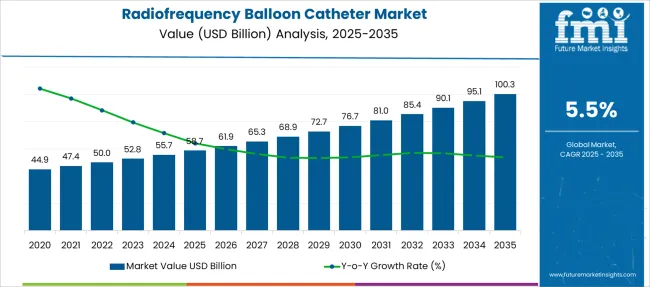
| Metric | Value |
|---|---|
| Radiofrequency Balloon Catheter Market Estimated Value in (2025 E) | USD 58.7 billion |
| Radiofrequency Balloon Catheter Market Forecast Value in (2035 F) | USD 100.3 billion |
| Forecast CAGR (2025 to 2035) | 5.5% |
The radiofrequency balloon catheter market is advancing steadily due to increasing demand for minimally invasive procedures and expanding applications in gastrointestinal and colorectal therapies. The growing prevalence of chronic conditions such as radiation induced proctitis has driven the adoption of targeted and controlled therapeutic interventions.
Radiofrequency balloon catheters offer the benefit of localized tissue ablation with minimal collateral damage and reduced procedural complications. Advances in catheter design, energy delivery precision, and temperature control mechanisms have further enhanced treatment efficacy and safety.
Clinical preference for outpatient based procedures and rapid patient recovery are additional factors supporting adoption. As healthcare providers continue to shift toward value based care and minimally invasive solutions, the market is projected to grow, with hospitals and specialty clinics playing a vital role in its integration into standard treatment protocols.
The market is segmented by Indication and End User and region. By Indication, the market is divided into Chronic hemorrhagic radiation proctitis and Malignant biliary strictures. In terms of End User, the market is classified into Hospitals, Clinics, Diagnostics Laboratories, and Others. Regionally, the market is classified into North America, Latin America, Western Europe, Eastern Europe, Balkan & Baltic Countries, Russia & Belarus, Central Asia, East Asia, South Asia & Pacific, and the Middle East & Africa.
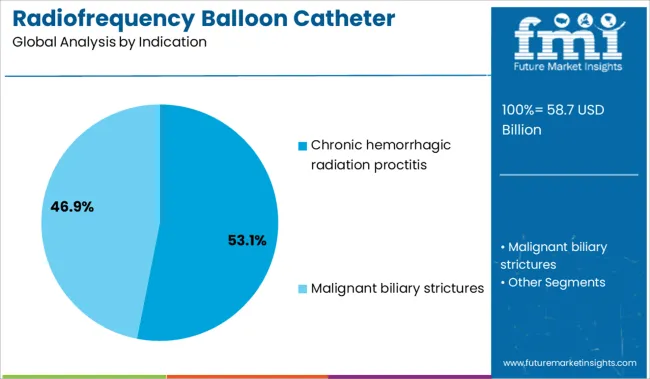
The chronic hemorrhagic radiation proctitis segment is anticipated to represent 53.10% of the total market revenue by 2025 within the indication category, establishing it as the most prominent therapeutic area. This is due to the rising number of patients undergoing pelvic radiotherapy, which frequently results in long term rectal complications requiring specialized treatment.
Radiofrequency balloon catheter systems provide targeted therapy by reducing mucosal bleeding and inflammation while preserving surrounding tissues. Clinical evidence supporting the efficacy of these systems in mitigating radiation induced damage has reinforced physician confidence and procedural uptake.
The need for effective and minimally invasive management solutions for post radiotherapy complications continues to grow, positioning this indication as the leading driver of market demand.
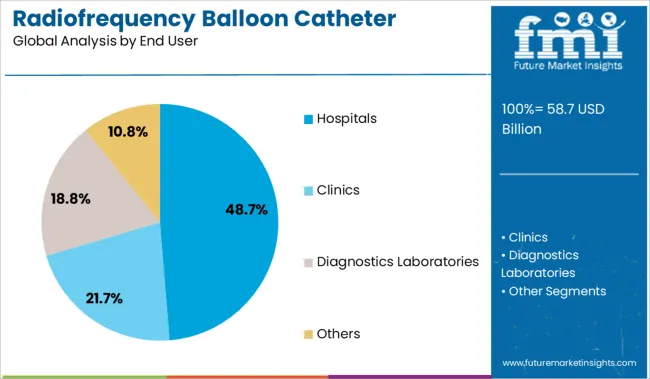
The hospital segment is projected to account for 48.70% of the market revenue by 2025 under the end user category, making it the leading healthcare setting. This dominance is attributed to the availability of advanced infrastructure, skilled interventional professionals, and broader patient access in hospital environments.
Hospitals also support multidisciplinary collaboration and are more likely to adopt new technologies through clinical trials and procurement frameworks. Furthermore, the increasing preference for minimally invasive treatment options within hospital based surgical units enhances the integration of radiofrequency balloon catheter procedures.
As institutional focus on efficient patient management and recovery intensifies, hospitals are expected to remain the largest contributors to product utilization and clinical adoption.
Rising cases of atrial fibrillation are placing a critical burden on the healthcare sector. According to the CDC, in 2035, an estimated 12.1 million people will suffer from atrial fibrillation in the USA
Applications of radiofrequency balloon catheters are expected to increase for the treatment of atrial fibrillation and pulmonary vein isolation. These devices are used to examine atrial fibrillation and are designed to optimize efficacy and safety and reduce treatment time. The radiofrequency energy of the radiofrequency balloon catheter helps the catheters move from the femoral vein to the left atrium and assists in examining atrial fibrillation.
With the advancement of technology and increasing investments in the healthcare sector, the adoption of radiofrequency balloon catheters will rise. In addition to this, the launch of new and advanced radiofrequency balloon catheters will also foster growth in the radiofrequency balloon catheter market
There are certain factors that may hamper the growth of the radiofrequency balloon catheter market. Radiofrequency balloon catheters require a skilled trainer to know and use the devices well since they require more functions to operate the devices.
A lack of skilled professionals and well-trained healthcare professionals may impede the growth of the radiofrequency balloon catheter market. Further, the rate of reproduction is less as compared to a cryoballoon.
The cost of the radiofrequency balloon catheter is high in comparison to other catheters. These factors are expected to limit sales in the market over the forecast period.
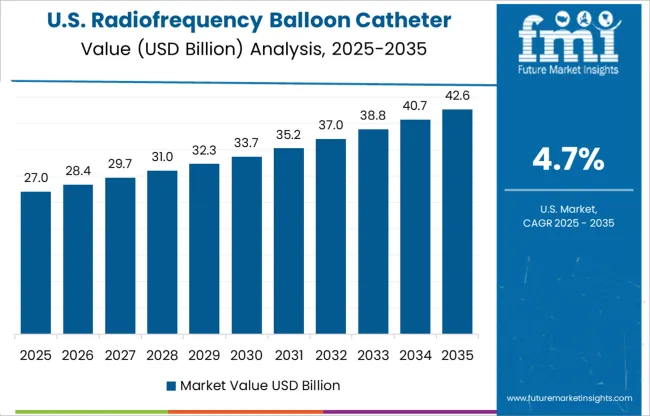
North America is predicted to witness growth at a considerable pace over the forecast period. Due to the rising adoption of new and advanced technologies, manufacturers are launching technologically-advanced radiofrequency balloon catheters.
The USA and Canada have recorded an increase in the incidence of chronic disorders owing to sedentary lifestyles. Additionally, the rising number of patients undergoing surgeries, and growing awareness of minimally invasive surgeries are factors that are anticipated to propel sales.
According to CDC, heart diseases account for one in every four deaths in the USA Each year there are about 659,000 deaths related to cardiovascular diseases in the USA Obesity, poor lifestyle habits such as a poor diet, physical inactivity, excessive alcohol intake, smoking, hypertension, and high cholesterol levels are some factors that cause cardiovascular diseases. About 50% of Americans exhibit at least one of these behavioral risk factors.
According to the IHME report published in 2020, ischemic heart disease was the leading cause of death and disability in Canada. Therefore, the rising incidence of peripheral artery disease, occlusions in blood vessels, and awareness of minimally invasive surgeries may boost demand for catheters in Canada.
Growing awareness among individuals about heart diseases, early diagnosis, and minimally invasive treatment options will underscore the requirement for radiofrequency balloon catheters across the Asia Pacific.
Significant growth can also be noted in the Japan radiofrequency balloon catheter market. This is owing to increased interest and investment in research and development of new healthcare facilities and treatment options. In addition to this, rising cases of atrial fibrillation in the country will augment the adoption of radiofrequency balloon catheters in the forthcoming years.
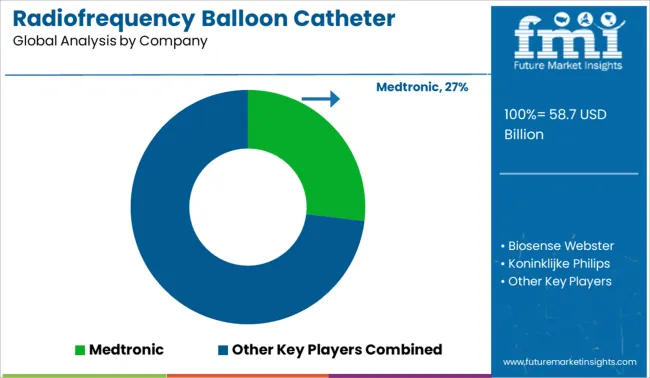
Some of the leading players operating in the radiofrequency balloon catheter market are Medtronic, and Biosense Webster, Inc.
These players are investing in research and development activities to incorporate the latest and advanced technologies to improve their product portfolios.
| Report Attribute | Details |
|---|---|
| Growth Rate (2025 to 2035) | 5.5% CAGR |
| Base Year for Estimation | 2024 |
| Historical Data | 2020 to 2024 |
| Forecast Period | 2025 to 2035 |
| Quantitative Units | Revenue in USD Million, and CAGR from 2025 to 2035 |
| Report Coverage | Revenue Forecast, Volume Forecast, Company Ranking, Competitive Landscape, Growth Factors, Trends, and Pricing Analysis |
| Segments Covered |
Indication, End User, Region |
| Countries Covered |
North America (USA, Canada), Latin America (Mexico. Brazil), Western Europe (Germany, Italy, France, United Kingdom, Spain, Nordic countries, Belgium, Netherlands, Luxembourg), Eastern Europe (Poland, Russia), Asia-Pacific Excluding Japan (China, India, ASEAN, Australia & New Zealand), Japan, The Middle East and Africa (GCC Countries, S. Africa, N. Africa) |
| Key Companies Profiled | Medtronic; Biosense Webster, Inc |
| Customization | Available Upon Request |
The global radiofrequency balloon catheter market is estimated to be valued at USD 58.7 billion in 2025.
The market size for the radiofrequency balloon catheter market is projected to reach USD 100.3 billion by 2035.
The radiofrequency balloon catheter market is expected to grow at a 5.5% CAGR between 2025 and 2035.
The key product types in radiofrequency balloon catheter market are chronic hemorrhagic radiation proctitis and malignant biliary strictures.
In terms of end user, hospitals segment to command 48.7% share in the radiofrequency balloon catheter market in 2025.






Full Research Suite comprises of:
Market outlook & trends analysis
Interviews & case studies
Strategic recommendations
Vendor profiles & capabilities analysis
5-year forecasts
8 regions and 60+ country-level data splits
Market segment data splits
12 months of continuous data updates
DELIVERED AS:
PDF EXCEL ONLINE
Radiofrequency (RF) Ablation System Market Size and Share Forecast Outlook 2025 to 2035
Balloon Catheters for Bile Stone Removal Market Size and Share Forecast Outlook 2025 to 2035
Balloon Catheters Analysis by Product Type by Indication and by End User through 2035
Cryoballoon Ablation System Market – Trends & Forecast 2025 to 2035
The Dual Balloon Angioplasty Catheter Market is segmented by Peripheral, and Coronal from 2025 to 2035
Micro Balloon Catheter Market Growth – Trends & Forecast 2025 to 2035
Cutting Balloons Market Insights – Growth, Demand & Forecast 2025 to 2035
Occlusion Balloon Catheter Market Size and Share Forecast Outlook 2025 to 2035
Serration Balloon Catheters Market
Stent Graft Balloon Catheter Market Insights - Growth & Forecast 2025 to 2035
Intra-Aortic Balloon Pump (IABP) Market Size and Share Forecast Outlook 2025 to 2035
Intra-gastric Balloons Market Size and Share Forecast Outlook 2025 to 2035
Pulmonary Dilation Balloon Market
Kidney Stone Extraction Balloon Market Size and Share Forecast Outlook 2025 to 2035
Middle East and Africa Latex Foil Balloons Market Size and Share Forecast Outlook 2025 to 2035
Catheter Market Insights by Product, Indication, End-user, and Region 2025 to 2035
Catheter-Directed Thrombolysis Market Growth - Trends & Forecast 2025 to 2035
Catheter Tip Syringe Market Size, Share & Demand Outlook 2025 to 2035
Catheter Associated Urinary Tract Infections (UTI) Treatment Market - Demand & Forecast 2025 to 2035
Catheter Systems Market

Thank you!
You will receive an email from our Business Development Manager. Please be sure to check your SPAM/JUNK folder too.
Chat With
MaRIA